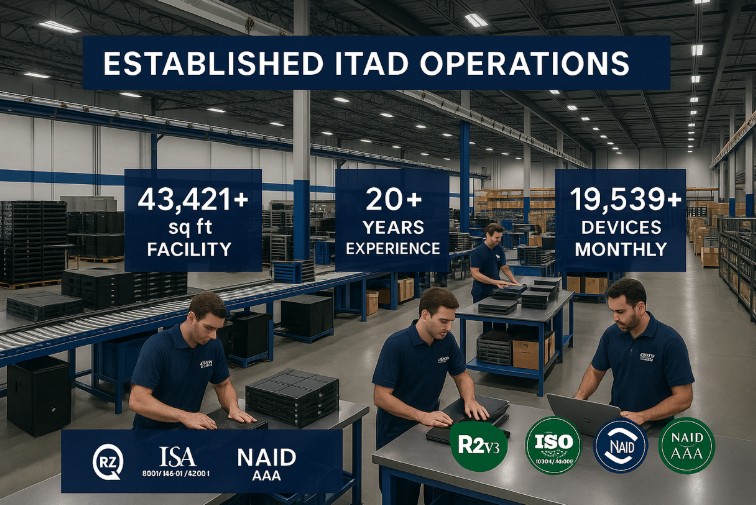Organizations are facing increasing pressure to balance technological advancement with environmental responsibility. As businesses continue to recognize the importance of sustainability goals and brand reputation, the strategic implementation of sustainable IT Asset Disposition (ITAD) programs has emerged as a critical component of modern business strategy.
According to research from Capgemini, 89% of companies recycle less than 10% of their IT hardware, highlighting a substantial opportunity for businesses to improve both their environmental impact and financial performance. This gap illustrates how sustainable ITAD practices can reshape the way organizations manage technology refresh cycles, reduce waste, and recover value from retired assets.
Understanding Sustainable IT Disposition
Sustainable IT disposition represents a fundamental shift from outdated, one-size-fits-all disposal practices to comprehensive lifecycle management focused on environmental responsibility, data security, and financial return
What is IT Asset Disposition?
IT Asset Disposition refers to the end-to-end management of technology assets as they are retired from service. Modern sustainable ITAD practices include:
- Asset discovery and inventory management – Using automated asset tracking systems and comprehensive asset databases
- Data sanitization and destruction – Implementing certified data destruction processes for compliance with privacy regulations
- Environmental compliance protocols – Ensuring adherence to regulations like WEEE and EPA standards
- Asset remarketing and reuse – Maximizing value recovery through strategic resale programs
- Material recovery and recycling – Supporting circular economy principles through certified e-waste recycling
The scope of contemporary ITAD programs extends far beyond simple disposal. It incorporates sophisticated asset tracking systems, data destruction protocols, and asset remarketing strategies, ensuring compliance with environmental regulations and data protection requirements while recovering as much residual value as possible.
Why ITAD Matters in Business Strategy
Integrating ITAD into broader business strategy transforms how organizations manage end-of-life IT equipment. Core benefits include:
- Risk mitigation – Minimizes the threat of data breach and regulatory non-compliance
- Operational efficiency – Streamlines refresh cycles and reduces administrative burden
- Cash flow optimization – Speeds up asset disposition and improves financial forecasting
- Competitive advantage – Signals environmental leadership and operational excellence
- Stakeholder value creation – Supports ESG reporting and builds investor trust
Companies that embrace sustainable IT disposition can see up to a 20% reduction in operational costs, according to recent studies on green IT initiatives.
Financial Impact of Sustainable IT Disposition
Sustainable IT disposition programs generate measurable financial returns well beyond the immediate costs of basic disposal. These programs unlock new revenue streams, reduce operational costs, and create long-term value through responsible lifecycle management.
Asset Reclaim and Remarketing: A Direct Path to Cost Efficiency
Asset reclaim and remarketing are among the most impactful sources of financial return from sustainable ITAD programs. Organizations implementing systematic asset remarketing programs can typically recover 15-30% of the original purchase price for equipment that’s 3-5 years old.
Key components that drive asset recovery success include:
- Professional refurbishment – Restoring equipment to like-new condition to enhance resale value
- Market timing optimization – Using real-time market intelligence for optimal pricing
- Multi-channel sales strategies – Leveraging diverse platforms and buyers to match equipment types
- Warranty and documentation support – Providing comprehensive service records and certifications to boost resale trust
- Volume consolidation – Streamlining logistics and achieving better pricing through bulk remarketing
Market analysis and pricing optimization play crucial roles in maximizing the financial returns from asset remarketing activities. Successful ITAD programs incorporate real-time market intelligence and dynamic pricing strategies that account for factors such as equipment age, condition, market demand, and seasonal fluctuations in pricing.
E-waste Recycling: Lower Costs, Higher Returns
Certified e-waste recycling delivers both environmental benefits and significant cost savings compared to traditional disposal methods. The financial advantages include:
- Eliminated landfill disposal fees – Avoid high and rising costs associated with dumping e-waste
- Material recovery revenue – Extract valuable components like gold, copper, and rare earth metals
- Regulatory compliance – Prevent penalties and maintain good standing by aligning with environmental standards
- Tax incentives – Benefit from state or federal green IT programs and sustainability credits
- Reduced insurance risk – Minimize exposure tied to improper disposal or data leaks
Modern e-waste recyclers use advanced separation and recovery processes that yield both cost savings and environmental impact reduction, making them a smart business investment.
Calculating ROI for ITAD Programs
Calculating the return on investment (ROI) for sustainable IT disposition programs requires a comprehensive analysis that accounts for both direct financial benefits and indirect value creation. Organizations with mature ITAD programs typically achieve:
- 15-35% asset recovery rates – Depending on equipment type, condition, and market timing
- Negative total disposition costs – Where resale revenue offsets or exceeds ITAD expenses
- Risk mitigation value – Mitigating potential penalties and security incidents
- Operational efficiency gains – Reducing time and resources involved in end-of-life IT management
- Cash flow acceleration – Completing the disposition in weeks rather than months
Research reinforces the value of ESG-aligned operations. A PwC study found that 76% of consumers would stop doing business with a company if they neglected environmental, social, and governance (ESG) principles, while KPMG reports that 45% of CEOs agree that ESG programs enhance financial performance.
Environmental Benefits of Sustainable IT Disposition
Sustainable IT disposition programs represent a critical component of organizational sustainability efforts, aligning with corporate sustainability goals and regulatory demands. These programs offer measurable gains in carbon reduction, waste diversion, and long-term ecological stewardship.
Reducing the Environmental Footprint of IT Operations
The IT sector accounts for almost 4% of global greenhouse gas emissions, with manufacturing activities representing a substantial portion of this impact. Sustainable IT asset disposition directly reduces these environmental pressures by extending the useful life of IT equipment and diverting e-waste from landfills.
Key environmental impact reduction strategies include:
- Reducing manufacturing demand – Extending equipment lifecycles through refurbishment and reuse
- Minimizing material extraction – Reducing demand for virgin materials through recycling
- Optimizing energy consumption – Improving equipment utilization and efficiency
- Decreasing transportation emissions – Utilizing local processing and remarketing facilities
- Lowering water consumption – Decreasing manufacturing-related water usage
Electronic equipment manufacturing represents one of the most environmentally intensive aspects of the technology lifecycle, consuming substantial quantities of energy, water, and raw materials while generating significant carbon emissions and environmental waste. By extending the useful life of IT equipment through refurbishment and remarketing activities, sustainable ITAD programs significantly reduce the demand for new equipment manufacturing.
Meeting Environmental Compliance Standards
Regulatory compliance represents a critical driver for sustainable IT disposition programs, as organizations face increasingly stringent requirements for electronic waste management and environmental impact reporting.
Key regulations influencing ITAD practices include:
- WEEE Directive (EU) – Comprehensive lifecycle responsibility requirements
- EPA Guidelines (U.S.) – Federal standards for electronic waste management
- State and local laws – Varying requirements across jurisdictions
- Basel Convention – Regulates cross-border movement of hazardous waste
- Data protection rules (e.g., GDPR) – Overlap with ITAD through secure data disposal
The complexity of environmental regulatory compliance makes it essential for organizations to work with certified ITAD providers that maintain current knowledge of applicable regulations and implement comprehensive compliance management systems.
Boosting Brand Reputation Through Green IT Practices
The implementation of sustainable IT disposition programs delivers significant brand reputation benefits that contribute to customer loyalty, stakeholder confidence, and competitive advantage.
Brand reputation enhancement occurs through:
- Measurable sustainability metrics – Concrete data on waste diversion and carbon reduction
- Third-party certifications – Industry-recognized validation of environmental practices
- Stakeholder transparency – Clear communication of environmental performance
- Employee engagement – Demonstrating organizational commitment to sustainability
- Competitive differentiation – Leadership in corporate environmental responsibility
A growing body of research supports these outcomes. Nearly 70% of businesses report that prioritizing ecological considerations improves their brand reputation, while 66% of global consumers are willing to pay more for sustainable products and services from environmentally responsible businesses.
Strategies for Implementing Sustainable ITAD
The successful implementation of sustainable IT Asset Disposition programs requires a comprehensive strategic approach that integrates environmental objectives, financial optimization, and operational efficiency into a cohesive framework.
Integrating Sustainability into ITAD Operations
The integration of sustainability principles into ITAD processes requires a fundamental shift from traditional disposal-focused approaches toward comprehensive lifecycle management. This integration must be embedded throughout the entire asset lifecycle.
Key integration strategies include:
- Sustainable procurement – Evaluating environmental impact in purchasing decisions
- Lifecycle planning optimization – Maximizing asset utilization and planning end-of-life processing
- Circular economy adoption – Promoting reuse, refurbishment, and material recovery
- Data security alignment – Balancing environmental goals with security requirements
- Environmental performance tracking – Establishing metrics to measure sustainability and financial returns
Sustainable procurement practices form the foundation of integrated ITAD sustainability. This includes evaluating vendors for their recycling policies, product durability, and support for responsible end-of-life options.
Setting KPIs for Monitoring ITAD Success
The development and implementation of comprehensive key performance indicators (KPIs) for sustainable ITAD programs requires a balanced approach that captures both environmental and financial performance while providing actionable insights for continuous improvement.
Recommended KPIs include:
- Waste diversion rate – Percentage of assets diverted from landfills (target: 95% or higher)
- Material recovery rate – Percentage of components or materials successfully recovered (target: 85-95%)
- Carbon footprint reduction – Greenhouse gas emission reductions achieved (target: 70-90%)
- Asset recovery rate – Percentage of original value recouped through resale or refurbishment (target: 15-35%)
- Disposition turnaround time – Average days from decommissioning to final processing (target: less than 30 days)
These metrics enable organizations to track progress and communicate the ROI of sustainability efforts to both internal and external stakeholders.
Collaboration Across IT and Business Departments
Effective ITAD implementation requires collaboration across IT, finance, procurement, legal, and sustainability teams. Critical areas include:
- IT department integration – Technical assessments and data security coordination
- Finance team alignment – Asset valuation, ROI tracking, and revenue recognition
- Procurement coordination – Vendor management and acquisition planning
- Legal and compliance support – Regulatory guidance and risk management
- Sustainability and ESG oversight – Strategy alignment and performance reporting
The Role of Technology in ITAD
The integration of advanced technology solutions into IT Asset Disposition programs has revolutionized the efficiency, accuracy, and transparency of asset management processes. Organizations can now achieve superior environmental and financial outcomes with the assistance of automation and analytics.
Streamlining ITAD with Automation Tools
Automation technologies transform ITAD operations by eliminating manual processes and accelerating asset processing. Key technologies include:
- Automated asset discovery – Identify and inventory assets through real-time network scanning
- RFID and barcode tracking – Monitor device movement and status from decommissioning to final processing
- Automated data destruction – Schedule secure, standards-compliant erasure with certified logging
- Workflow automation platforms – Use conditional rules to trigger next steps, reducing delays and human error
These tools reduce processing time, improve chain-of-custody accuracy, and reduce risk by enforcing security and compliance protocols at each stage.
Advanced Reporting Tools for Better Decision-Making
Advanced reporting systems deliver real-time visibility and data-driven decision-making. With the right dashboards in place, ITAD teams can better optimize operations and demonstrate compliance.
Capabilities include:
- Real-time dashboard – Immediate visibility into performance metrics
- Financial performance analysis – Detailed ROI and cost-benefit tracking
- Environmental impact reporting – Comprehensive sustainability metrics
- Compliance audit trails – Complete disposition activity records
Looking Ahead: The Future of Sustainable IT Disposition
The future of sustainable IT disposition is being shaped by converging trends in technology innovation, regulatory evolution, and changing stakeholder expectations. Cumulatively, these are driving fundamental transformations in how organizations approach asset lifecycle management.
The Circular Economy Trends Shaping the ITAD Landscape
The circular economy is shifting ITAD from a disposal-focused model to one that emphasizes reuse, repair, and remanufacturing. Forward-thinking companies are embracing:
- Design for circularity – Equipment designed for longevity and material recovery
- Extended producer responsibility – Manufacturer lifecycle accountability
- Material passport systems – Blockchain-enabled transparency and traceability
- Product-as-a-Service models – Service-based technology consumption
These practices extend asset life, reduce waste, and create scalable models for sustainable technology management.
The Future of Sustainable IT Disposition
The integration of sustainable IT disposition into core business strategy represents a fundamental shift toward recognizing ITAD as a strategic capability. This contributes directly to competitive advantage through value creation, innovation enablement, and market differentiation.
By integrating circular economy principles, leveraging automation, and aligning ITAD with ESG priorities, companies can future-proof their asset management strategies and lead in a sustainability-driven marketplace.
Explore OEM Source for certified and sustainable solutions that protect your data, recover value, and align with your corporate sustainability goals.
Frequently Asked Questions
How can sustainable IT disposition support business continuity?
By maintaining organized asset tracking, efficient refresh cycles, and clear end-of-life processes, sustainable ITAD programs help minimize downtime, reduce risk exposure, and ensure operational stability during technology transitions or audits.
What is the typical ROI timeline for sustainable ITAD programs?
Most organizations begin to see positive returns within 6-12 months, with full ROI often realized within 18-24 months through a combination of cost savings, asset recovery, and remarketing revenue.
How do organizations ensure data security during disposition?
Professional ITAD providers employ certified data destruction following NIST 800-88 standards for data destruction. They also provide detailed Certificates of Data Destruction to verify secure handling and support audit readiness.
How can sustainable ITAD programs support broader ESG initiatives?
Sustainable ITAD programs contribute directly to Environmental, Social, and Governance (ESG) goals by reducing carbon emissions, diverting e-waste from landfills, supporting ethical reuse of equipment, and providing transparency through reporting. These efforts strengthen ESG performance metrics and enhance stakeholder trust.
What types of IT assets are eligible for remarketing or reuse?
Commonly remarketed assets include laptops, desktops, servers, networking equipment, and even some mobile devices. Devices less than 5 years old in good condition tend to offer the highest recovery value when refurbished and resold.





